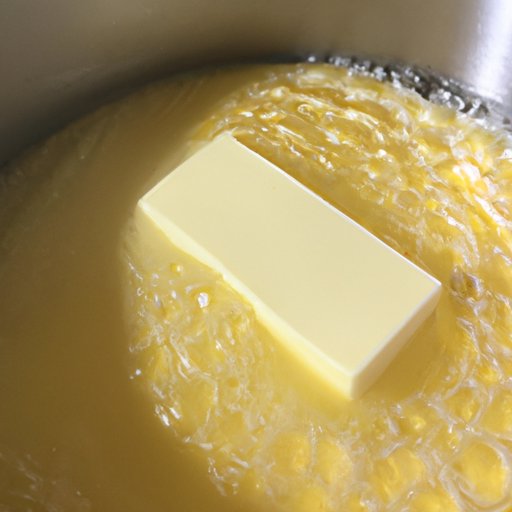
An Overview of the Meaning of “Reduce” in Cooking
When it comes to cooking, there are countless techniques that can be used to take a dish from good to great. One such technique is reduction, which is a process of evaporating liquid from a food or drink in order to concentrate its flavors. Here we’ll explore what reduce means in cooking and how it can be used to add depth and complexity to your dishes.
Definition of Reduction
Reduction is a cooking technique that involves evaporating liquid from a food or beverage in order to concentrate its flavors. This can be done by heating a liquid over a stovetop, in an oven, or even on a grill. The goal of reduction is to create a thicker, more flavorful sauce or broth that will enhance the overall taste and texture of a dish.
Common Uses of Reduction
Reduction is often used in sauces and gravies, as well as soups and stews. It can also be used to make reductions for glazes and marinades, which are then used to add flavor and texture to dishes. In addition, reduction can be used to make syrups and other sweet treats.

Exploring Different Methods of Reduction in the Kitchen
There are several methods for reducing liquids in the kitchen. Let’s take a look at some of the most common ones.
Boiling
Boiling is one of the simplest ways to reduce liquids. To do this, simply bring the liquid to a boil and let it simmer until the desired consistency is achieved. Be sure to stir frequently to prevent burning or sticking.
Simmering
Simmering is similar to boiling, but it is done at a lower temperature. To simmer, bring the liquid to just below a boil and let it cook for a longer period of time. This method is often used when making stocks or sauces, as it allows the flavors to meld together.
Roasting
Roasting is another way to reduce liquids. This is done by placing the liquid in a roasting pan and allowing it to cook slowly in an oven. The heat of the oven causes the liquid to evaporate, resulting in a thickened sauce or stock.

The Benefits of Reducing Liquids in Recipes
Reducing liquids has multiple benefits in the kitchen. Here are some of the most notable ones:
Concentration of Flavor
One of the main benefits of reducing liquids is that it concentrates the flavor of the liquid. This is due to the evaporation of water, which leaves behind the more concentrated flavor molecules. As a result, the flavors of the liquid become more intense, making the dish more flavorful.
Thickening of Sauces and Gravies
Another benefit of reducing liquids is that it thickens sauces and gravies. This is because as the liquid evaporates, the remaining liquid becomes thicker and more viscous. This makes it easier to spread the sauce or gravy onto food and gives the dish a more luxurious texture.
Enhancing Texture
Reducing liquids can also help to enhance the texture of a dish. By removing excess moisture, the food becomes more dense and has a richer mouthfeel. This is especially useful when making soups and stews, as it helps to thicken them up and make them more satisfying.
Tips and Tricks for Reducing Sauces and Other Dishes
When reducing liquids, there are a few tips and tricks that can help ensure success. Here are some of the most helpful ones:
Use a Wide Pot or Saucepan
When reducing liquids, it’s important to use a wide pot or saucepan. This will help to increase the surface area of the liquid, which will allow more of the liquid to evaporate. A wider pot or saucepan will also help to prevent the liquid from boiling over.
Stir Frequently
It’s also important to stir the liquid frequently while reducing it. This will help to prevent the liquid from sticking to the bottom of the pot or saucepan and will also help to evenly distribute the heat. Stirring also ensures that all of the ingredients are properly combined.
Consider Adding Aromatics
Adding aromatics such as herbs and spices can help to enhance the flavor of the reduced liquid. These can be added at any point during the reduction process, but it’s best to add them near the end so that their flavors don’t get cooked out.
Using Reduction to Enhance Flavor and Texture in Your Cooking
Reducing liquids is a great way to add depth and complexity to your dishes. Here are some of the ways you can use reduction to enhance the flavor and texture of your cooking:
Create a Glaze
Reducing liquids can be used to create a delicious glaze for meats, vegetables, and other dishes. Simply reduce a mixture of liquids such as wine, vinegar, honey, or maple syrup and brush it on the food before serving.
Make a Compound Butter
Reducing liquids can also be used to make a compound butter. To do this, reduce a liquid such as wine, beer, or juice and mix it with softened butter. This can then be used to add flavor and richness to dishes such as roasted vegetables, steak, or fish.
Add Depth of Flavor to Soups and Stews
Finally, reducing liquids can be used to add depth of flavor to soups and stews. Simply reduce a mixture of liquids such as wine, stock, or juice and add it to the pot. This will give the soup or stew an extra layer of flavor and make it more satisfying.
Conclusion
By reducing liquids, you can add complexity and depth of flavor to your dishes. From creating glazes and compound butters to adding flavor to soups and stews, reducing liquids is a simple yet effective way to elevate your cooking. With these tips and tricks, you’ll be able to master the art of reduction with ease.


